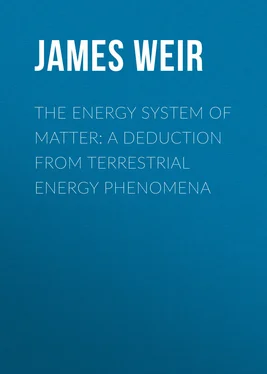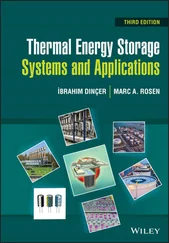James Weir - The Energy System of Matter - A Deduction from Terrestrial Energy Phenomena
Здесь есть возможность читать онлайн «James Weir - The Energy System of Matter - A Deduction from Terrestrial Energy Phenomena» — ознакомительный отрывок электронной книги совершенно бесплатно, а после прочтения отрывка купить полную версию. В некоторых случаях можно слушать аудио, скачать через торрент в формате fb2 и присутствует краткое содержание. Жанр: foreign_antique, Физика, foreign_edu, на английском языке. Описание произведения, (предисловие) а так же отзывы посетителей доступны на портале библиотеки ЛибКат.
- Название:The Energy System of Matter: A Deduction from Terrestrial Energy Phenomena
- Автор:
- Жанр:
- Год:неизвестен
- ISBN:нет данных
- Рейтинг книги:3 / 5. Голосов: 1
-
Избранное:Добавить в избранное
- Отзывы:
-
Ваша оценка:
- 60
- 1
- 2
- 3
- 4
- 5
The Energy System of Matter: A Deduction from Terrestrial Energy Phenomena: краткое содержание, описание и аннотация
Предлагаем к чтению аннотацию, описание, краткое содержание или предисловие (зависит от того, что написал сам автор книги «The Energy System of Matter: A Deduction from Terrestrial Energy Phenomena»). Если вы не нашли необходимую информацию о книге — напишите в комментариях, мы постараемся отыскать её.
The Energy System of Matter: A Deduction from Terrestrial Energy Phenomena — читать онлайн ознакомительный отрывок
Ниже представлен текст книги, разбитый по страницам. Система сохранения места последней прочитанной страницы, позволяет с удобством читать онлайн бесплатно книгу «The Energy System of Matter: A Deduction from Terrestrial Energy Phenomena», без необходимости каждый раз заново искать на чём Вы остановились. Поставьте закладку, и сможете в любой момент перейти на страницу, на которой закончили чтение.
Интервал:
Закладка:
8. Interactions of Two Planetary Bodies—Equilibrium Phenomena
Up to the present point, the cosmical system has been assumed to be composed of one planetary body only in addition to the primary mass. It is clear, however, that by repetition of the process already described, the system could readily evolve more than one planet; it might, in fact, have several planetary masses originating in the same primary, each endowed with a definite modicum of energy, and each pursuing a persistent orbit round the central axis of the system. Since the mass of the primary decreases as each successive planet is cast off, its gravitative attractive powers will also decrease, and with every such decline in the central restraining force the orbits of the previously constituted planets will naturally widen. By the formation in this way of a series of planetary masses, the material of the original primary body would be as it were distributed over a larger area or space, and this separation would be accompanied by a corresponding decrease in the gravitative attraction between the several masses. If the distributive or disruptive process were carried to its limit by the continuous application of rotatory energy to each separate unit of the system, this limit would be dependent on the capacity of the system for energy. As is shown later (§ 20), this capacity would be determined by the mass of the system.
For simplicity, let us consider the case in which there are two planetary bodies only in the system in addition to the primary. In virtue of the gravitative attraction or gravitation field between the two, they will mutually attract one another in their motion, and each will, in consequence, be deflected more or less out of that orbital path which it would normally pursue in the absence of the other. This attraction will naturally be greatest when the planets are in the closest proximity; the planet having the widest orbit will then be drawn inwards towards the central axis, the other will be drawn outwards. The distance moved in this way by each will depend on its mass, and on the forces brought to bear on it by the combined action of the two remaining masses of the system. Moving thus in different directions, the motion of each planet is carried out in the lines of the gravitation field between the two. One planet, therefore, gains and the other loses energy of position with respect to the central axis of the system. The one planet can thus influence, to some extent, the energy properties of the other, although there is absolutely no direct energy communication between the two; as shown hereafter, the whole action and the energy change will be due simply to the motion carried out in the field of the incepting gravitation influence.
It is clear, however, that this influence is exerted on the distribution of the energy, on the form in which it is manifested, and in no way affects the energy totality of either planet. Each, as before, remains a separate system with conservative energy properties. That planet which loses energy of position gains energy of motion, and is correspondingly accelerated in its orbital path; the other, in gaining energy of position, does so at the expense of its own energy of motion, and is retarded accordingly. The action is really very simple in nature when viewed from a purely energy standpoint. It has been dealt with in some detail in order to emphasise the fact that there is absolutely nothing in the nature of a transmission of energy between one planet and the other. Taking a superficial view of the operation, it might be inferred that, as the planets approach one another, energy of motion (or energy of position) is transmitted from one to the other, causing one to retard and the other to accelerate its movement, but a real knowledge of the energy conditions shows that the phenomenon is rather one of a simple restoration of equilibrium, a redistribution or transformation of the intrinsic energy of each to suit these altering conditions. Each planet is, in the truest sense, a separate mass in space.
9. Axial Energy—Secondary Processes
Passing now to another aspect of the energy condition of a planetary body, let the planet be assumed to be endowed with axial energy or energy of rotation, so that, while pursuing its orbital path in space, it also rotates with uniform angular velocity about an axis within itself. What will be the effect of the primary mass on the planet under these new energy conditions? We conceive that the effect is again purely one of transformation. In this process the primary mass functions once more as an entirely passive or incepting agent, which, while exerting a continuous transforming influence on the planet, does not affect in any way the inherent energy properties of the latter. Up to the present point we have only dealt with one incepting influence in transformation processes, namely, that of gravitation, which has always been manifested as an attractive force. It is not to be supposed, however, that this is the only aspect in which incepting influences may be presented. Although attractive force is certainly an aspect of some incepting influences, it is not a distinctive feature of incepting influences generally. In many cases, the aspect of force, in the sense of attraction or repulsion, is entirely awanting. In the new order of transformations which come into play in virtue of the rotatory motion of a planetary mass in the field of its primary, we shall find other incepting influences in action entirely different in nature from the gravitation influence, but, nevertheless, arising from the same primary mass in a similar way. Now the application of energy to the planet, causing it to rotate in the lines or under the influence of these incepting fields of the primary, brings into existence on the planet an entirely new order of phenomena. So long as the planet had no axial motion of rotation, some of the incepting influences of the primary were compelled, as it were, to inaction; but with the advent of axial energy the conditions are at once favourable to their action, and to the detection of their transforming effects. In accordance with the general principle already enunciated (§ 4), the action of the planetary energised material in the lines of the various incepting fields of the primary is productive of energy transformations. The active energy of these transformations is the axial or energy rotatory of the planet itself, and, in virtue of these transformations, certain other forms of energy will be manifested on the planet and associated with the various forms of planetary material. These manifestations of energy, in fact, constitute planetary phenomena. Since the action or movement of the rotating material of the planet through the incepting fields of the primary is most pronounced in the equatorial or regions of highest linear velocity, and least in the regions of low velocity adjoining the poles of rotation, the transforming effect may naturally be expected to decrease in intensity from equator to poles. Planetary energy phenomena will thus vary according to the location of the acting material. It will be clear, also, that each incepting agency or influence associated with the primary mass will give rise to its own peculiar transformations of axial energy on the planetary surface. These leading or primary transformations of axial energy, in which the incepting influence is associated with the primary mass only, we term primary processes. But it is evident that the various forms of energy thus set free on the planet as a result of the primary processes will be communicated to, and will operate on, the different forms of planetary material, and will give rise to further or secondary transformations of energy, in which the incepting agency is embodied in or associated with planetary material only. The exact nature of these secondary transformations will vary according to the circumstances in which they take place. Each of them, however, as indicated above, will be, in itself, carried out in virtue of some action of the energised planetary material in the lines or field of what we might term a secondary incepting influence. The latter, however, must not be confused with the influences of the primary. It is essentially a planetary phenomenon, an aspect of planetary energy; it is associated with the physical or material machine by means of which the secondary process of transformation is carried out. The nature of this secondary influence will determine the nature of the secondary transformation in each case. Its precise extent may be limited by other considerations (§ 15).
Читать дальшеИнтервал:
Закладка:
Похожие книги на «The Energy System of Matter: A Deduction from Terrestrial Energy Phenomena»
Представляем Вашему вниманию похожие книги на «The Energy System of Matter: A Deduction from Terrestrial Energy Phenomena» списком для выбора. Мы отобрали схожую по названию и смыслу литературу в надежде предоставить читателям больше вариантов отыскать новые, интересные, ещё непрочитанные произведения.
Обсуждение, отзывы о книге «The Energy System of Matter: A Deduction from Terrestrial Energy Phenomena» и просто собственные мнения читателей. Оставьте ваши комментарии, напишите, что Вы думаете о произведении, его смысле или главных героях. Укажите что конкретно понравилось, а что нет, и почему Вы так считаете.












